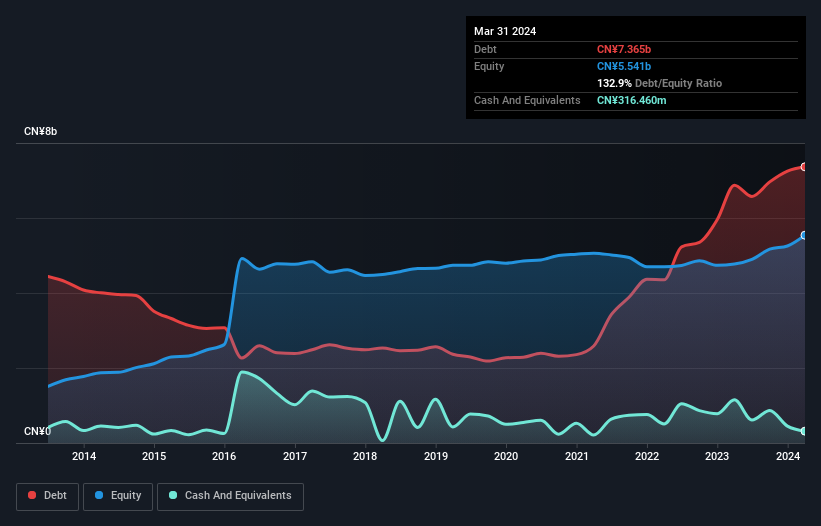David Iben put it well when he said, 'Volatility is not a risk we care about. What we care about is avoiding the permanent loss of capital.' It's only natural to consider a company's balance sheet when you examine how risky it is, since debt is often involved when a business collapses. Importantly, Jiangxi Ganneng Co., Ltd. (SZSE:000899) does carry debt. But the more important question is: how much risk is that debt creating?
What Risk Does Debt Bring?
Debt is a tool to help businesses grow, but if a business is incapable of paying off its lenders, then it exists at their mercy. In the worst case scenario, a company can go bankrupt if it cannot pay its creditors. However, a more common (but still painful) scenario is that it has to raise new equity capital at a low price, thus permanently diluting shareholders. Having said that, the most common situation is where a company manages its debt reasonably well - and to its own advantage. When we examine debt levels, we first consider both cash and debt levels, together.
View our latest analysis for Jiangxi Ganneng
What Is Jiangxi Ganneng's Debt?
You can click the graphic below for the historical numbers, but it shows that as of March 2024 Jiangxi Ganneng had CN¥7.37b of debt, an increase on CN¥6.88b, over one year. However, because it has a cash reserve of CN¥316.5m, its net debt is less, at about CN¥7.05b.

A Look At Jiangxi Ganneng's Liabilities
The latest balance sheet data shows that Jiangxi Ganneng had liabilities of CN¥1.87b due within a year, and liabilities of CN¥6.37b falling due after that. Offsetting these obligations, it had cash of CN¥316.5m as well as receivables valued at CN¥610.1m due within 12 months. So it has liabilities totalling CN¥7.31b more than its cash and near-term receivables, combined.
This is a mountain of leverage relative to its market capitalization of CN¥10.7b. This suggests shareholders would be heavily diluted if the company needed to shore up its balance sheet in a hurry.
We use two main ratios to inform us about debt levels relative to earnings. The first is net debt divided by earnings before interest, tax, depreciation, and amortization (EBITDA), while the second is how many times its earnings before interest and tax (EBIT) covers its interest expense (or its interest cover, for short). This way, we consider both the absolute quantum of the debt, as well as the interest rates paid on it.
Jiangxi Ganneng has a debt to EBITDA ratio of 5.0 and its EBIT covered its interest expense 6.5 times. This suggests that while the debt levels are significant, we'd stop short of calling them problematic. Notably, Jiangxi Ganneng's EBIT launched higher than Elon Musk, gaining a whopping 553% on last year. When analysing debt levels, the balance sheet is the obvious place to start. But it is Jiangxi Ganneng's earnings that will influence how the balance sheet holds up in the future. So if you're keen to discover more about its earnings, it might be worth checking out this graph of its long term earnings trend.
Finally, a business needs free cash flow to pay off debt; accounting profits just don't cut it. So we clearly need to look at whether that EBIT is leading to corresponding free cash flow. Over the last two years, Jiangxi Ganneng saw substantial negative free cash flow, in total. While that may be a result of expenditure for growth, it does make the debt far more risky.
Our View
Neither Jiangxi Ganneng's ability to convert EBIT to free cash flow nor its net debt to EBITDA gave us confidence in its ability to take on more debt. But the good news is it seems to be able to grow its EBIT with ease. When we consider all the factors discussed, it seems to us that Jiangxi Ganneng is taking some risks with its use of debt. So while that leverage does boost returns on equity, we wouldn't really want to see it increase from here. There's no doubt that we learn most about debt from the balance sheet. However, not all investment risk resides within the balance sheet - far from it. For example Jiangxi Ganneng has 3 warning signs (and 1 which is concerning) we think you should know about.
At the end of the day, it's often better to focus on companies that are free from net debt. You can access our special list of such companies (all with a track record of profit growth). It's free.
New: Manage All Your Stock Portfolios in One Place
We've created the ultimate portfolio companion for stock investors, and it's free.
• Connect an unlimited number of Portfolios and see your total in one currency
• Be alerted to new Warning Signs or Risks via email or mobile
• Track the Fair Value of your stocks
Have feedback on this article? Concerned about the content? Get in touch with us directly. Alternatively, email editorial-team (at) simplywallst.com.
This article by Simply Wall St is general in nature. We provide commentary based on historical data and analyst forecasts only using an unbiased methodology and our articles are not intended to be financial advice. It does not constitute a recommendation to buy or sell any stock, and does not take account of your objectives, or your financial situation. We aim to bring you long-term focused analysis driven by fundamental data. Note that our analysis may not factor in the latest price-sensitive company announcements or qualitative material. Simply Wall St has no position in any stocks mentioned.
About SZSE:000899
Jiangxi Ganneng
Engages in power generation and transmission business in China.
Proven track record average dividend payer.
Market Insights
Community Narratives



